How to Get a 30-day Employee to a 30-year Performance Level
Learn how to develop a strategy that improves workforce agility and flexibility for the generations to come with LNS Research Analyst Allison Kuhn.
Environment, Health, and Safety (EHS) software is no longer a nice to have for manufacturers to achieve long-term success in a dynamic and competitive global landscape. The dramatic increase in risk and demands for more sustainable operations has only raised the bar for solution providers to deliver more robust, integrated, and connected solutions to manage risk, ensure compliance, and retain talent proactively. The sixty-four percent of industrial organizations that have already adopted or are piloting enterprise EHS Management and Sustainability software is a strong indicator of the value these solutions provide and are a huge enabler to sustainable manufacturing.
Adopting commercially available software has enabled manufacturers to significantly improve Total Recordable Case Rates. Unfortunately, meaningful improvements in industrial fatalities have proven to be much more challenging. What’s worse, manufacturers are seeing an uptick in injuries.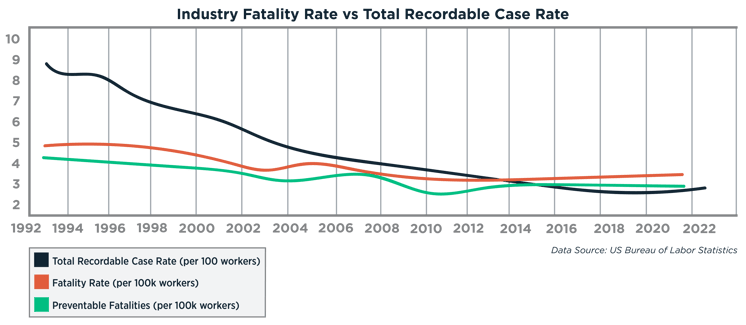
Changing workforce dynamics will continue challenging industrial organizations on the Journey to Zero+. Proactively managing risk in this new environment will be a strategic imperative for manufacturers. To drive progress toward aggressive Sustainability commitments, leaders must adopt sustainable policies and practices that include workforce engagement efforts to improve Sustainability performance.
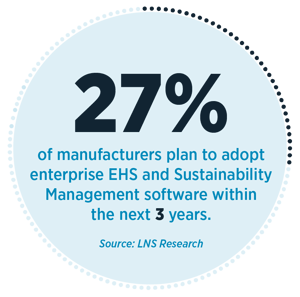 Fortunately, many EHS software providers are investing heavily in newer, advanced techniques and technology to provide risk-based, actionable insights to support decision-making and enhance the overall employee experience. More human-centric design actively engages the workforce at every level across the organization. One of the biggest trends in broadening and extending the functionality of offerings has been continued market consolidation.
Fortunately, many EHS software providers are investing heavily in newer, advanced techniques and technology to provide risk-based, actionable insights to support decision-making and enhance the overall employee experience. More human-centric design actively engages the workforce at every level across the organization. One of the biggest trends in broadening and extending the functionality of offerings has been continued market consolidation.
This blog explores how the evolving EHS software market enables an Operation 2030 strategy to overcome today’s workforce challenges and ultimately deliver on the expectations for more sustainable manufacturing.
Today’s manufacturing environment has seen a dramatic increase in risk as The Great Goodbye continues to ravage the frontlines. Seventy-six percent of manufacturers report significant workforce challenges. Gone are the days of the 2019, pre-pandemic workforce.
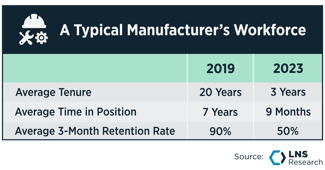 Employee tenure has gone from a historical 30-year career to a three-year job. The average time in position has gone from seven years to nine months in just four years. Given the dramatic increase in risk seen from many different factors, including geopolitical, brand and consumer, economic, product, and the colossal shift in workforce dynamics, the time to act is now.
Employee tenure has gone from a historical 30-year career to a three-year job. The average time in position has gone from seven years to nine months in just four years. Given the dramatic increase in risk seen from many different factors, including geopolitical, brand and consumer, economic, product, and the colossal shift in workforce dynamics, the time to act is now.
The only way for industrial leaders to balance multiple and often competing business objectives is to invest in innovative leadership, strategy, and culture approaches. Operations 2030 is a broader manufacturing strategy, incorporating EHS and Sustainability, Autonomous Plant, Future of Industrial Work (FOIW), Unified Performance Excellence (UPX), and Collaborative Quality initiatives spanning people, process, and technology to accelerate the Journey to Zero+. This strategy is critical to achieving financial and business objectives, where digital technology is an enabler that ensures compliance, attracts talent, and positions the company for long-term success in a dynamic and competitive global landscape.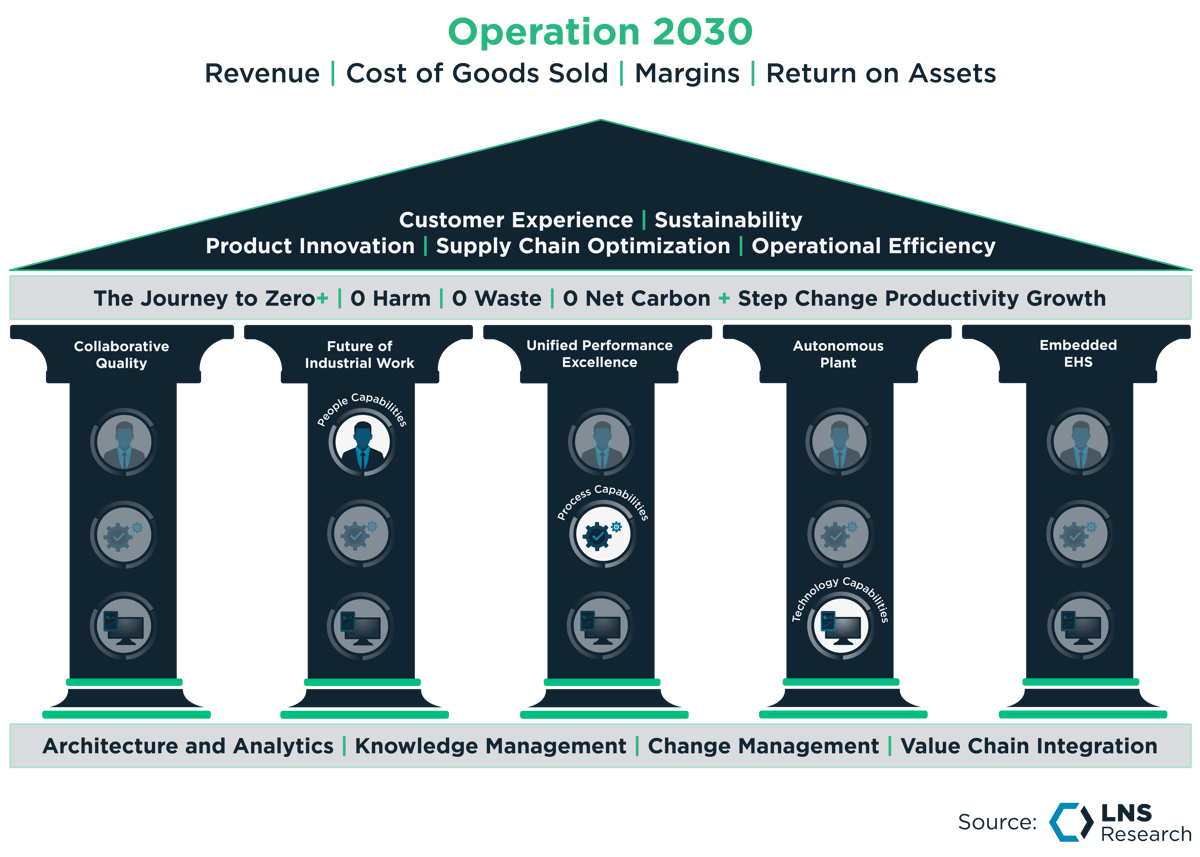
Fortunately for industrial organizations, help is on the way in the form of innovative new technology. Commercial EHS Management solution providers have moved well beyond providing solutions across environment, health, and safety use cases. Leading software providers have expanded into the adjacent areas of operational risk, quality, and sustainability management to provide robust EHS and Sustainability Management offerings within one unified platform.
These advances allow the VPs of EHS to partner with operations and enable the business to hit the company’s overall goals. Adopting new techniques and technology can create value by changing culture, behavior, and outcomes. New paths to executive leadership are possible when focusing on more than lagging EHS performance metrics and protecting the license to operate.
The need to improve overall Sustainability performance has driven a relatively mature EHS space to evolve further over the last few years. There have been three noticeable trends that have begun to differentiate performance across manufacturing. EHS management has grown significantly from the software solutions first developed by manufacturers out of necessity for:
The broad adoption of commercially available enterprise EHS Management software.
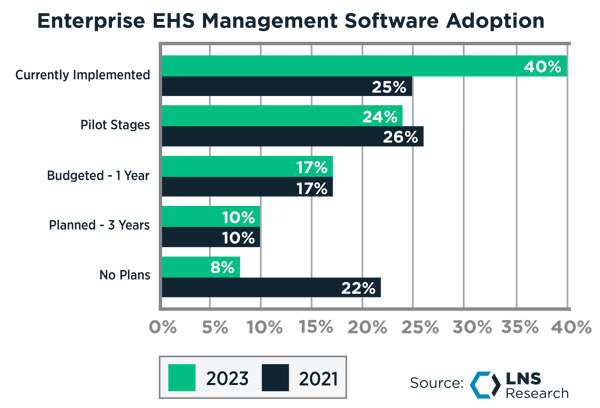
Stronger integration with and connectivity between advanced technologies such as Internet of Things (IoT) devices, Artificial Intelligence (AI), Machine Learning (ML), Connected Frontline Workforce (CFW) applications, and more.
EHS and Sustainability Management combined into a common platform to expand operational and intelligent risk management (ORM and IRM) capabilities.
Manufacturers who aren’t looking for solutions to future-proof today’s systems and practices are already behind. Commercially available EHS Management solutions enable industrial organizations to engage employees better and improve onboarding, training, and risk management capabilities. These improvements deliver better safety, quality, and productivity performance, contributing to the overall goals of the Operation 2030 strategy.
Commercially available software has become recognized as a means to enable industrials to manage compliance, regulatory, and supply chain risk better at the enterprise level. EHS and Sustainability Management solutions will better enable companies to implement green practices and build the inclusive environment that stakeholders demand. Adopting innovative new ways of work, techniques, and tools is critical to overcoming the dangerous, dirty, and dull perception in manufacturing.
Industrial organizations face declining tenure, an aging workforce, and early retirements. When it comes to improving Sustainability performance overall, manufacturers are finding that traditional ways of training the workforce and managing risk are no longer efficient or effective. New approaches are needed to meet the challenges presented by evolving workforce dynamics and the fast pace of today’s manufacturing environment.
These more holistic and comprehensive software providers can streamline data collection, analysis, and reporting, enabling informed risk-based decision-making. Enterprise EHS Management software can apply AI and ML to large volumes of IoT device data to provide predictive and prescriptive analytics. When connected with CFW applications, workers have access to the data and information they need when they need it and, in many cases, can alert employees to unrecognized risks.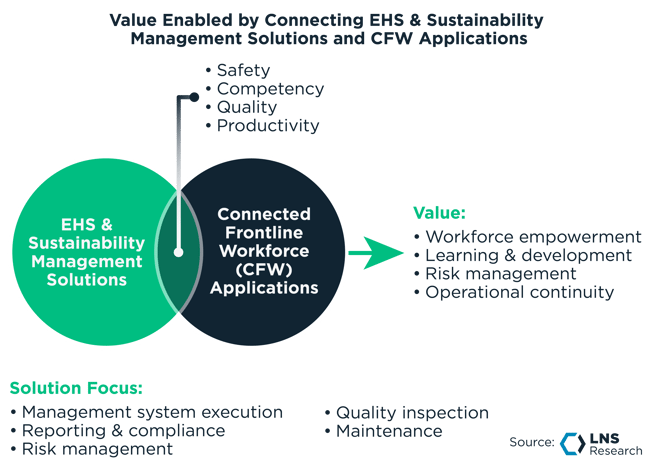
The risks we see within today’s complex environment will only worsen as the loss of experienced personnel becomes more painful. EHS and Sustainability Management software is essential to achieving operations and business goals. Newer applications focus more on improving employee engagement and workforce competency, a strategic imperative for the Future of Industrial Work.
An Operation 2030 strategy is a key enabler in ensuring compliance, attracting talent, and gaining a competitive advantage in today’s rapidly evolving, volatile environment. Replacing legacy and homegrown EHS Management systems with commercially available solutions enables more efficient and effective health, safety, environmental, and quality program management. Manufacturers can proactively improve overall Sustainability performance and accelerate the Journey to Zero+ by seeking vendors with both EHS and Sustainability offerings.
The number of offerings and range of capabilities will only grow as advanced technologies mature. Healthy competition and an infusion of private equity have fueled M&A activity, such as Hexagon’s acquisition of EtQ, to broaden EHS and Sustainability Management offerings. LNS Research believes industrial software providers such as Emerson, Honeywell, Rockwell Automation, Siemens, and Schneider Electric should take note of these trends and build a broader portfolio by leveraging what they have learned from their internal EHS and Sustainability initiatives.
As the market evolves, Industrial organizations must navigate the broad range of offerings and innovative solutions. The good news is that by following a proven process, EHS and Sustainability Leaders can avoid the many pitfalls and challenges of solution selection. Follow these recommendations to navigate the market landscape better:
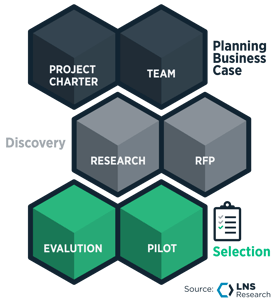 Collaboration is critical to the solution selection process. Software solution selection should begin with multi-level, multi-regional, cross-functional, and inter-departmental collaboration. Global Heads of EHS, Sustainability, and Operations must work together to proactively manage future risks and opportunities across a wide range of environmental, health, and safety business processes. Eliminate alignment, buy-in, time, cost, and risk in solution selection concerns by engaging the organization from the beginning.
Collaboration is critical to the solution selection process. Software solution selection should begin with multi-level, multi-regional, cross-functional, and inter-departmental collaboration. Global Heads of EHS, Sustainability, and Operations must work together to proactively manage future risks and opportunities across a wide range of environmental, health, and safety business processes. Eliminate alignment, buy-in, time, cost, and risk in solution selection concerns by engaging the organization from the beginning.
Focus on finding trusted partners rather than solution providers. Look to partner with a vendor that has a forward-thinking product development strategy that includes in-house development, external acquisitions, and strategic partnerships. Trusted advisors understand the challenges faced across manufacturing and can challenge the status quo to deliver step-change improvements. Identify vendors with proven capability in developing innovative offerings, supporting deployment, achieving scale, and providing return on investment.
Determine the ability to meet industry and or regulatory-specific requirements. The new paradigm shift towards Sustainability continues to change the reporting landscape. Look for platforms capable of strong system and data integration with pre-built connectors, an ecosystem of solutions, and partnerships. Industrials need to ensure the selected providers can meet the organization’s needs today and have a roadmap of the vendor ecosystem to adapt to changing stakeholder requirements.
Look for interoperable solutions and an ecosystem of solutions. Focus on data management, workflow interoperability, and a system of systems approach to support the control of work, regulatory compliance, and risk management. Agility in architecture is critical to long-term success, so beware of the easy-to-develop and integrate pitch where initial costs are just the beginning in terms of the total cost of ownership, degree of difficulty, and time to value. Broad functionality, such as seamless reporting for compliance, and the application of emerging digital technology, such as Generative AI for better, faster decision-making, are essential for solutions to deliver meaningful value.
Identify the providers capable of meeting future needs. Ensure providers can demonstrate the ability to execute against a strong roadmap of future capabilities and functionality to enable step-change improvements. Offerings should integrate with solutions and architecture in place today. As needs change, solutions must be able to adapt to new challenges and opportunities.
The days of a 30-year career and the performance of 2019 aren’t coming back with the negative impacts on safety, quality, and productivity we see today, just the beginning. To meet global demands, organizations must have the right tools and technology to achieve aggressive Sustainability goals and prepare for the future. Industrials must accept changing workforce dynamics and adopt newer working methods that support, engage, and empower the workforce to mitigate the increased risk to people, planet, and profit.
As a member-level partner of LNS Research, you will receive our expert and proven Advisory Services. These exclusive benefits give your team:
Let us help you with key decisions based on our solid research methodology and vast industrial experience.
BOOK A STRATEGY CALLLearn how to develop a strategy that improves workforce agility and flexibility for the generations to come with LNS Research Analyst Allison Kuhn.
Explore the CFW applications space as LNS Research Analyst Allison Kuhn delves into the offerings of today's Operations Collaboration & Execution...
Unlock a new level of operational performance with LNS Research as we explore the importance of achieving a Connected Frontline Workforce in today's...
The Industrial Transformation and Operational Excellence Blog is an informal environment for our analysts to share thoughts and insights on a range of technology and business topics.